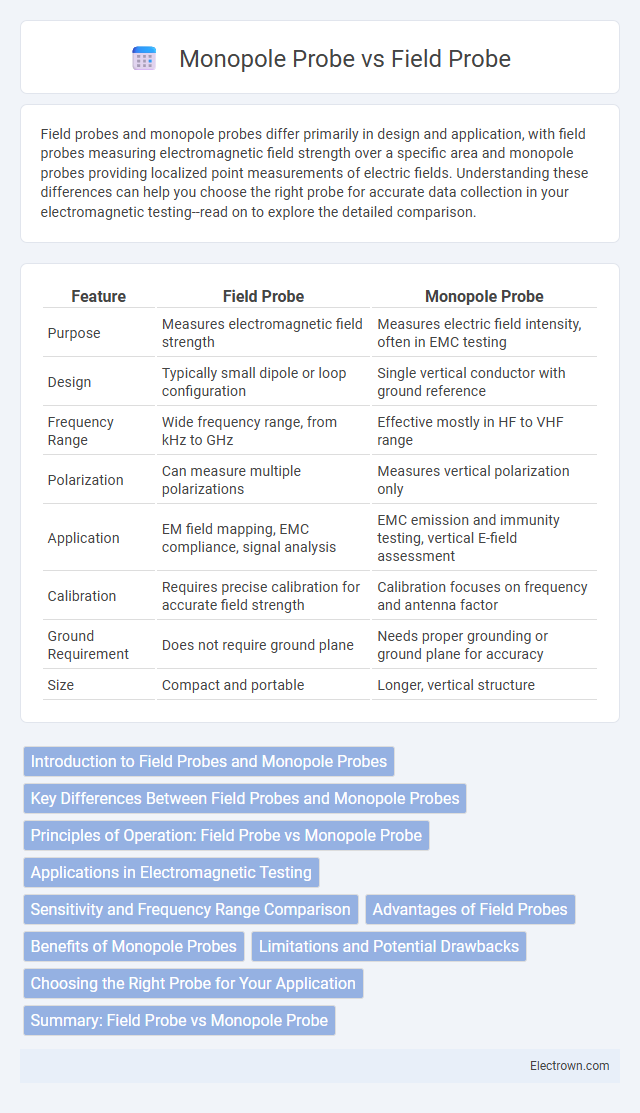Field probes and monopole probes differ primarily in design and application, with field probes measuring electromagnetic field strength over a specific area and monopole probes providing localized point measurements of electric fields. Understanding these differences can help you choose the right probe for accurate data collection in your electromagnetic testing--read on to explore the detailed comparison.
Table of Comparison
| Feature | Field Probe | Monopole Probe |
|---|---|---|
| Purpose | Measures electromagnetic field strength | Measures electric field intensity, often in EMC testing |
| Design | Typically small dipole or loop configuration | Single vertical conductor with ground reference |
| Frequency Range | Wide frequency range, from kHz to GHz | Effective mostly in HF to VHF range |
| Polarization | Can measure multiple polarizations | Measures vertical polarization only |
| Application | EM field mapping, EMC compliance, signal analysis | EMC emission and immunity testing, vertical E-field assessment |
| Calibration | Requires precise calibration for accurate field strength | Calibration focuses on frequency and antenna factor |
| Ground Requirement | Does not require ground plane | Needs proper grounding or ground plane for accuracy |
| Size | Compact and portable | Longer, vertical structure |
Introduction to Field Probes and Monopole Probes
Field probes measure electromagnetic fields by detecting variations in electric or magnetic field components, offering precise spatial resolution for antenna characterization and near-field measurements. Monopole probes function as simplified, single-element antennas designed to receive or transmit signals over a broad frequency range, commonly used in spectrum monitoring and interference detection. Differences in design influence their application, with field probes excelling in detailed field mapping and monopole probes suited for general signal detection.
Key Differences Between Field Probes and Monopole Probes
Field probes measure electromagnetic field strength by detecting both electric and magnetic components, providing a comprehensive analysis of the field distribution. Monopole probes, typically consisting of a single conductive element, primarily sense the electric field component and are often used for localized measurement or calibration. Your choice depends on the accuracy needed and the specific application, with field probes offering broader frequency response and directional sensitivity compared to the simpler and more compact monopole probes.
Principles of Operation: Field Probe vs Monopole Probe
Field probes measure electromagnetic fields by detecting voltage or current induced by the field over a known area or volume, offering accurate spatial sampling of field distribution. Monopole probes operate as single conductive elements that capture electromagnetic energy by coupling directly to the field, primarily responding to the electric field component with simpler impedance characteristics. Understanding these principles helps you choose the right probe based on desired sensitivity, frequency response, and measurement environment.
Applications in Electromagnetic Testing
Field probes excel in electromagnetic testing by providing precise measurements of spatial electromagnetic field distributions, making them ideal for antenna characterization and near-field scanning. Monopole probes, with their simple design and sensitivity to electric fields, are commonly used for EMC testing and detecting radiated emissions in RF circuits. Their complementary roles enable comprehensive assessment of electromagnetic interference and radiated power in wireless communication systems.
Sensitivity and Frequency Range Comparison
Field probes generally offer higher sensitivity due to their capability to capture electric and magnetic field components with minimal interference, making them ideal for accurate electromagnetic measurements. Monopole probes, typically optimized for specific frequency bands, exhibit a narrower frequency range but provide robust performance within their targeted spectrum, often excelling in high-frequency detection. The frequency range of field probes spans from low MHz to several GHz, while monopole probes usually operate efficiently within a mid to upper GHz range, influencing their respective applications in RF and EMC testing.
Advantages of Field Probes
Field probes offer superior spatial resolution and accuracy compared to monopole probes, making them ideal for precise electromagnetic field measurements. Their ability to capture both electric and magnetic field components provides comprehensive data critical for detailed analysis in RF testing and antenna characterization. You benefit from enhanced measurement reliability and reduced interference effects, ensuring more consistent and trustworthy results in complex environments.
Benefits of Monopole Probes
Monopole probes offer significant advantages such as simpler design, easier calibration, and cost-effectiveness compared to field probes. Their compact size allows for convenient measurements in confined spaces without sacrificing accuracy. Monopole probes also provide consistent impedance matching, enhancing signal integrity and reliability in electromagnetic field testing.
Limitations and Potential Drawbacks
Field probes often face limitations such as sensitivity to environmental noise and difficulty in measuring localized electromagnetic fields with high spatial resolution. Monopole probes may exhibit reduced accuracy in complex field distributions due to their directional sensitivity and inherent antenna pattern distortions. Both probe types can experience calibration challenges and frequency response limitations, impacting the precision of electromagnetic field measurements in varying operational contexts.
Choosing the Right Probe for Your Application
Selecting the right probe for your application depends on factors such as measurement environment and frequency range. Field probes provide precise, localized electromagnetic field measurements ideal for near-field testing, while monopole probes excel in broader frequency detection and simplicity. Understanding your specific testing requirements will ensure your probe delivers accurate and reliable data.
Summary: Field Probe vs Monopole Probe
Field probes measure electromagnetic fields with high spatial resolution by detecting near-field distributions, making them ideal for antenna characterization and EMC testing. Monopole probes operate as simple antennas, primarily detecting radiated fields with less spatial precision but broader frequency response. Choosing between a field probe and a monopole probe depends on measurement goals like spatial accuracy and frequency range.
Field probe vs monopole probe Infographic

 electrown.com
electrown.com